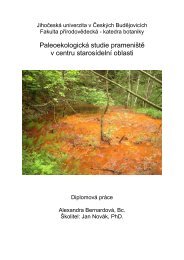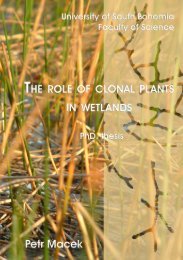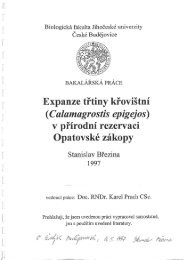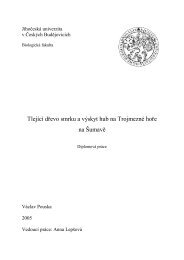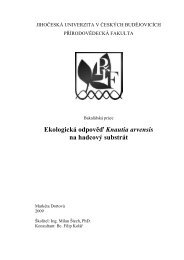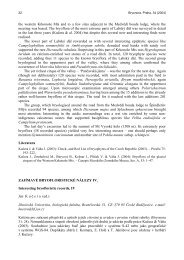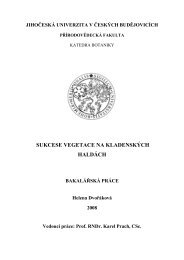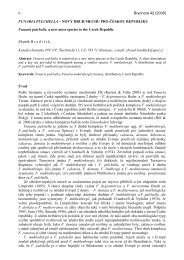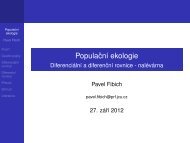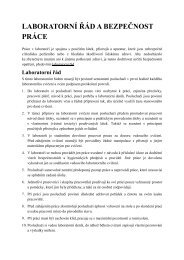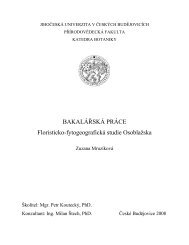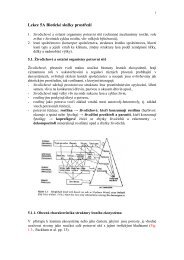NOVÁ LICHENOLOGICKÁ LITERATURA XXI. New lichenological ...
NOVÁ LICHENOLOGICKÁ LITERATURA XXI. New lichenological ...
NOVÁ LICHENOLOGICKÁ LITERATURA XXI. New lichenological ...
Create successful ePaper yourself
Turn your PDF publications into a flip-book with our unique Google optimized e-Paper software.
Bryonora 51 (2013) 57<br />
Pino-Bodas R., Martín M. P. & Burgaz A. R. (2012): Cladonia subturgida and C. iberica<br />
(Cladoniaceae) form a single, morphologically and chemically polymorphic species. –<br />
Mycological Progress 11: 269–278.<br />
Polovinka M. P. et al. (2012): Secondary metabolites of the lichen Cladonia stellaris. –<br />
Chemistry of Natural Compounds 48: 392–395.<br />
Prieto M., Martínez I., Aragón G., Gueidan C. & Lutzoni F. (2012): Molecular phylogeny of<br />
Heteroplacidium, Placidium, and related catapyrenioid genera (Verrucariaceae, lichenforming<br />
Ascomycota). – American Journal of Botany 99: 23–35.<br />
Printzen C., Cezanne R., Eichler M. & Lumbsch H. T. (2012): The genera Aphanopsis and<br />
Steinia represent basal lineages within Leotiomyceta. – Bibliotheca Lichenologica 108:<br />
177–186.<br />
Printzen C., Fernández-Mendoza F., Muggia L., Berg G. & Grube M. (2012):<br />
Alphaproteobacterial communities in geographically distant populations of the lichen<br />
Cetraria aculeata. – FEMS Microbiology Ecology 82: 316–325.<br />
Pykälä J., Stepanchikova I. S., Himelbrant D. E., Kuznetsova E. S. & Alexeeva N. M. (2012):<br />
The lichen genera Thelidium and Verrucaria in the Leningrad Region (Russia). – Folia<br />
Cryptogamica Estonica 49: 45–57.<br />
Rai H., Upreti D. K. & Gupta R. K. (2012): Diversity and distribution of terricolous lichens as<br />
indicator of habitat heterogeneity and grazing induced trampling in a temperate-alpine shrub<br />
and meadow. – Biodiversity and Conservation 21: 97–113.<br />
Rajakaruna N. et al. (2012): Investigation of the importance of rock chemistry for saxicolous<br />
lichen communities of the <strong>New</strong> Idria serpentinite mass, San Benito County, California,<br />
USA. – Lichenologist 44: 695–714.<br />
Randlane T., Saag A., Martin L., Timdal E. & Nimis P. L. (2011): Epiphytic macrolichens of<br />
Estonia. – Ülikooli Kirjastus, Tartu.<br />
Rapai S. B., McMullin R. T. & <strong>New</strong>master S. G. (2012): The importance of macrolichen traits<br />
and phylogeny in forest community assemblage along a high elevation gradient in<br />
southwestern British Columbia. – Forest Ecology and Management 274: 231–240.<br />
Riddell J., Padgett P. E. & Nash III T. H. (2012): Physiological responses of lichens to<br />
factorial fumigations with nitric acid and ozone. – Environmental Pollution 170: 202–210.<br />
Rivas Plata E., Lücking R. & Lumbsch H. T. (2012): A new classification for the family<br />
Graphidaceae (Ascomycota: Lecanoromycetes: Ostropales). – Fungal Diversity 52: 107–<br />
121.<br />
Rohrer A., Bilowitz P. O. & Mayrhofer H. (2012): Lichenized fungi from the Jakupica<br />
mountain range (Macedonia, FYROM). – Herzogia 25: 167–175.<br />
Roof S. & Werner A. (2011): Indirect Growth Curves remain the best choice for lichenometry:<br />
Evidence from directly measured growth rates from Svalbard. – Arctic, Antarctic, and<br />
Alpine Research 43: 621–631.<br />
Roux C. (2012): Liste des lichens et champignons lichénicoles de France. Listo de la likenoj<br />
kaj nelikeniĝintaj fungoj de Francio. – Bulletin de la Société linnéenne de Provence 16: 3–<br />
220.<br />
Ruprecht U., Brunauer G. & Printzen C. (2012): Genetic diversity of photobionts in Antarctic<br />
lecideoid lichens from an ecological viewpoint. – Lichenologist 44: 661–678.<br />
Ruprecht U., Lumbsch H. T., Brunauer G., Green T. G. A. & Türk R. (2012): Insights into the<br />
Diversity of Lecanoraceae (Lecanorales, Ascomycota) in continental Antarctica (Ross Sea<br />
region). – Nova Hedwigia 94: 287–306.



